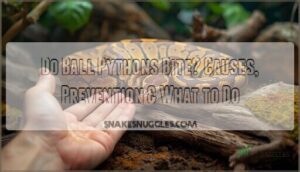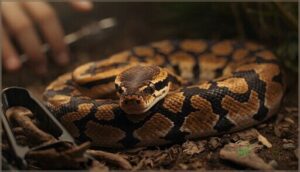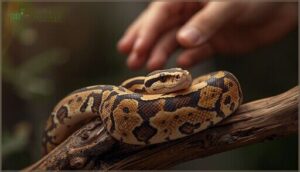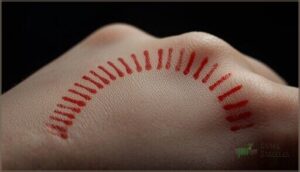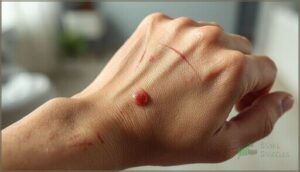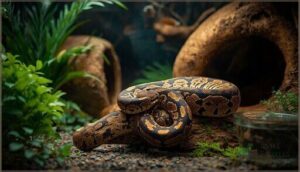This site is supported by our readers. We may earn a commission, at no cost to you, if you purchase through links.
Your new ball python coils peacefully in its enclosure, and you’re keen to handle it—but there’s a nagging worry in the back of your mind. Yes, ball pythons can bite, but here’s the reassuring truth: they’re among the most docile pet snakes available, and bites usually happen for predictable, preventable reasons.
These shy creatures would rather curl into a defensive ball than strike, which is exactly how they earned their name. Understanding what triggers defensive behavior and how to read your snake’s body language transforms bite prevention from guesswork into straightforward care.
Whether you’re considering your first ball python or you’ve experienced an unexpected nip, knowing the causes, risks, and proper responses gives you the confidence to handle your snake safely.
Table Of Contents
- Key Takeaways
- Do Ball Pythons Bite?
- Why Ball Pythons May Bite
- Are Ball Python Bites Dangerous?
- What Does a Ball Python Bite Look Like?
- How to Prevent Ball Python Bites
- What to Do if Bitten by a Ball Python
- When to Seek Medical Attention
- Keeping Ball Pythons Safe and Healthy
- Frequently Asked Questions (FAQs)
- How painful is a ball python bite?
- Do ball pythons like to be held?
- Are ball pythons friendly?
- Can ball pythons become aggressive?
- How often do ball pythons bite their owners?
- What are the signs of an imminent bite?
- Are certain ball python morphs more prone to biting?
- Can ball python bites transmit diseases or infections?
- How do ball python bites compare to other snakes?
- Can ball pythons bite through gloves or clothing?
- Conclusion
Key Takeaways
- Ball pythons rarely bite and are among the most docile pet snakes, with most bites stemming from predictable triggers like stress, hunger cues, shedding discomfort, or defensive fear rather than aggression.
- These snakes are completely non-venomous constrictors whose bites typically cause minimal pain (1-2 out of 10), leave shallow curved puncture marks from small backward-facing teeth, and heal within 7-10 days with proper wound care.
- You can prevent most bites by recognizing warning signs like S-shaped neck posture and hissing, avoiding handling during shedding, washing hands to remove prey scent, and using proper two-handed support techniques that don’t trigger defensive responses.
- Creating a stress-free environment with correct temperatures (88-92°F warm side, 75-80°F cool side), 50-60% humidity, secure hides, and brief routine handling sessions (10-20 minutes, 3-5 times weekly) drastically reduces bite likelihood while building trust.
Do Ball Pythons Bite?
Ball pythons do bite, but it’s not something that happens every day. Most owners with years of experience tell the same story—their snakes stay calm and choose curling up over striking. Survey data from reptile communities backs this up: only a minority of keepers report being bitten at all, and when it does happen, it’s usually linked to a specific trigger rather than random aggression.
You’ll generally see defensive behavior before a bite occurs. Watch for an S-shaped neck and hissing—those are your snake’s way of saying it’s uncomfortable. Sometimes a ball python will strike with its mouth closed, which doesn’t even break skin. The takeaway? Bites are context-dependent, not routine. Your ball python isn’t a ticking time bomb; it’s a shy animal that would rather hide than fight. Understanding pet snake bite protocols can help owners prepare for potential emergencies.
Why Ball Pythons May Bite
Ball pythons don’t bite out of aggression—they bite when something in their world feels off. Understanding the triggers behind these bites helps you prevent them and handle your snake with confidence.
Ball pythons bite when something in their world feels off, not out of aggression
Let’s look at the most common reasons your ball python might strike.
Defensive Bites and Stress
Fear drives most defensive snake bites you’ll see in captivity. When your ball python feels cornered or stressed, it shifts into survival mode—tight coiling, hissing, and that telltale S-shaped neck posture before striking.
Common stress triggers that increase defensive behavior:
- Sudden movements or reaching directly toward the head during handling
- Improper temperatures (warm side below 88–92°F, cool side above 82°F)
- Missing hides or sparse enclosures that leave them feeling exposed
- Loud noises, vibrations, or frequent disturbances near the habitat
- Excessive handling, especially with newly acquired or juvenile snakes
Recognizing these anxiety signals helps you avoid bites altogether. Proper handling techniques, such as those found in snake handling guides, are essential for reducing stress in ball pythons.
Hunger and Feeding Response
Hunger cues trigger a different kind of snake bite entirely—one that isn’t about fear at all. When your ball python smells rodent scent on your hands or you open the enclosure near feeding time, those feeding instincts kick in fast.
Strike mechanics become lightning-quick as prey presentation signals food, and your pet snake doesn’t pause to double-check what it’s targeting. Food motivation overrides caution, turning an otherwise docile ball python into a reactive hunter chasing hunger cues.
Shedding and Illness
When your ball python is about to shed skin, cloudy eyes and dull scales reduce vision, triggering defensive bites if you handle them. Shedding stress lasts 7–15 days, and humidity control below 50–60% worsens incomplete sheds.
Illness signs like respiratory infection or mouth rot heighten snake pain, making even calm snakes reactive. Health monitoring matters—sick animals show threefold increases in defensive strikes, so respect shedding skin phases and watch for infection or animal health changes.
Young Ball Python Behavior
Hatchlings and juveniles strike more often than adults because they’re hardwired for defense—curling into tight balls or lashing out when you reach in too fast.
Ball python acclimation takes weeks; juvenile stress peaks in the first days after rehoming, so limit handling until your pet snake settles.
Regular, calm snake socialization during growth patterns builds trust, reducing defensive snake behavior and teaching young ball pythons that your hands aren’t threats.
Are Ball Python Bites Dangerous?
The good news is that ball python bites aren’t dangerous in the way venomous snake bites are. These snakes don’t have venom or fangs, so you won’t face toxins or serious medical emergencies.
That said, there are still a few things you should know about what actually happens when a ball python bites.
Non-Venomous Nature
One of the most reassuring facts about your ball python: it’s completely non-venomous. Unlike vipers or cobras, ball pythons lack venom glands and specialized fangs.
They’re constrictor snakes that rely on muscular coiling, not toxins, to subdue prey. Their solid, backward-curved teeth simply grip—no venom delivery system exists.
This nonvenomous snake dentition means a ball python bite poses zero risk of envenomation, making them safe pet snakes from a toxicity standpoint.
Bite Severity and Pain Level
Your pain threshold won’t be tested much—most ball python bites rank around 1–2 out of 10 on the pain scale. The bite force from these small constrictors produces mild, temporary discomfort.
Pain management? Usually unnecessary beyond basic first aid.
- Bite wounds appear as superficial puncture wounds or light scratches
- Snake bite pain peaks instantly, then fades within minutes
- Injury assessment reveals minimal tissue damage in typical cases
- Wound healing completes in roughly 7–10 days
Infection Risks
Infection doesn’t happen often, but bacterial transmission from python oral flora matters. Opportunistic pathogens like Pseudomonas can contaminate bite wounds, though shallow injuries rarely require antimicrobial therapy.
Salmonella poses separate public health risks—snakes carry it at high rates, though you’d contract it through fecal–oral routes, not bites.
Proper wound care and snake bite prevention through hygiene drastically cut your infection risk.
What Does a Ball Python Bite Look Like?
If your ball python does bite you, knowing what to expect can help you stay calm and respond properly. The appearance of the bite depends on how your snake made contact and how quickly you reacted.
Here’s what you’ll normally see after a ball python bite.
Curved Teeth Marks
A ball python bite leaves a telltale arc-shaped pattern that’s actually quite distinctive. Instead of two large fang marks, you’ll see many tiny puncture wounds arranged in a curved line—like a dotted semicircle on your skin. Here’s what makes these bite patterns unique:
- Fine tooth impressions: 10–20 needle-like marks following the jaw’s curve
- Shallow depth: Each puncture measures only 1–2 millimeters across
- Backward angle: Teeth marks slant toward the snake’s throat, not straight down
- Forensic clarity: Multiple small punctures distinguish nonvenomous constrictor bites from venomous snake strikes
This curved arrangement reflects the ball python’s recurved dental anatomy—around 25–35 small teeth per jaw, each angling inward to grip prey. The tighter the arc, the smaller the snake. When both jaws contact your hand, you might notice two parallel curved lines of punctures rather than one. These marks usually appear as bright red dots initially, sometimes with short scratches between punctures where teeth dragged during withdrawal.
Understanding this bite pattern helps you recognize a ball python bite immediately and confirms there’s no venom involved—just mechanical trauma that rarely leads to infection if you clean it promptly.
Scratches and Puncture Wounds
Most bites from a ball python produce shallow scratches alongside small puncture wounds—think pinprick dots rather than deep gashes. Emergency records show these injuries usually stay in the skin and superficial soft tissue, rarely reaching tendons or bone.
Here’s what you’re likely to see:
| Wound Type | Appearance | Depth |
|---|---|---|
| Scratches | Red lines, minor abrasions | Surface layer only |
| Puncture wounds | Small circular openings | 1–3 mm into skin |
| Soft tissue damage | Localized bruising | Shallow compression |
Proper wound cleaning with soap and water cuts your infection risk dramatically. Check your tetanus status—puncture wounds create narrow tracts where bacteria thrive. Even minor snake bites qualify as tetanus-prone injuries, so update your booster if it’s been over five years.
Most handling-related bites heal without complications when you address puncture depth and infection risk early.
Bruising or Swelling
Right after those puncture wounds appear, you’ll usually notice mild, localized swelling that stays put around the bite site—not the kind that creeps up your arm. Most bite reactions settle down within 24 to 48 hours when you keep the wound clean.
- Bruising forms from mechanical tissue compression, not venom
- Swelling that spreads or worsens signals possible infection
- Cold compresses help manage early soft tissue damage
Proper infection control keeps minor animal bites from turning into bigger problems during wound healing.
How to Prevent Ball Python Bites
Most ball python bites happen because of simple misunderstandings or stress, and the good news is you can avoid them with a few smart habits.
Understanding what triggers defensive behavior and how to handle your snake properly makes all the difference.
Here’s what actually works to keep both you and your ball python comfortable and bite-free.
Safe Handling Techniques
Gentle lifting makes all the difference. Support your ball python with both hands—front third and rear third—and let them move between your palms like they’re exploring branches. Avoid grabbing from above, which mimics predator attacks.
Use a snake hook when opening the enclosure to signal it’s not feeding time. Keep sessions short, handle from the side, and never lift by the tail alone.
Avoiding Prey Scent on Hands
Your hands carry stories your snake can read. Wash thoroughly with unscented soap before handling—residual prey odor from preparing rodents can trigger feeding strikes even hours later.
Alcohol-based sanitizers work well for skin decontamination after touching feeders. Better yet, use feeding tools like tongs to keep prey scent away from your fingers entirely.
Separate feeding tasks from handling sessions, and your ball python won’t mistake you for dinner.
Recognizing Warning Signs
Ball pythons broadcast their discomfort before they strike. A tight coil with the head tucked center-deep signals acute defensive stress. Hissing, rapid breathing, or an S-curved neck raised toward you are escalating warnings—your snake’s way of saying “back off.”
During shedding, those cloudy eyes reduce vision and spike defensiveness. Recognizing these behavioral indicators helps you avoid misreading stress signals as calm tolerance, preventing bites before defensive behavior turns into a defensive bite wound.
Proper Feeding Practices
Feeding your ball python correctly eliminates most feeding-response bites. Offer prey items around 10% of your snake’s body weight—a 500 g python gets a 50 g rodent—every two to three weeks for adults.
Use tongs to present frozen-thawed rodents warmed to body temperature. This meal sizing promotes digestive health without triggering hunger strikes.
Proper feeding frequency teaches your snake when food arrives, reducing hand-targeting mistakes entirely.
What to Do if Bitten by a Ball Python
If a ball python bites you, don’t panic—it’s usually more startling than harmful. Your first priority is staying calm and gently removing the snake if it hasn’t already let go.
Here’s what you need to do to clean the wound, prevent infection, and know when things might need more attention.
Immediate First Aid Steps
If your ball python latches on, stay calm—panicking only makes things worse. Here’s your emergency response plan:
- Remove the snake gently without pulling or twisting to avoid tearing tissue further
- Keep the bitten limb still and below heart level to limit swelling and bleeding
- Move away from the snake once free—don’t chase or restrain it
Now you’re ready for wound cleaning and proper first aid.
Cleaning and Bandaging The Wound
Proper wound irrigation is your first line of defense. Rinse the bite under running water for at least 5 minutes—longer is better for puncture wounds.
Use regular soap and water for wound cleansing, scrubbing gently to remove saliva and debris without damaging tissue. Pat dry, then apply a thin layer of antiseptic before covering with a loose, clean bandage for infection control.
Monitoring for Infection
Most infections don’t show up immediately—you’ll need to watch your wound carefully over the next few days. Check the bite site at least twice daily for these infection signs:
- Redness spreading beyond the original wound edges
- Increasing warmth, swelling, or pain around the bite
- Cloudy drainage or pus developing at puncture sites
- Fever above 100.4°F or general malaise
Good wound care and post-bite monitoring catch problems early, before they escalate into serious bacterial risks requiring aggressive treatment.
When to Seek Medical Attention
Most ball python bites heal on their own with basic first aid at home. But there are times when a trip to the doctor isn’t optional—it’s necessary.
Watch for these red flags that mean you need professional medical care.
Signs of Infection
Watch for redness, warmth, or swelling spreading beyond the bite area—these are classic infection symptoms that demand attention. Puncture wounds can trap bacteria deep in tissue, so if you see pus, red streaks tracking up your arm, or fever developing days after the bite, seek treatment immediately.
Snake bite treatment isn’t complete until you’ve ruled out wound infection and bacterial spread.
Deep or Severe Wounds
If you see bone, tendon, or joint exposed—or if bleeding won’t stop after five minutes of pressure—you need emergency care.
Deep puncture wounds from larger pythons can damage nerves and cause loss of sensation or movement.
Deep tissue injuries also carry much higher infection rates than shallow scratches, sometimes requiring surgical wound management and antibiotics to prevent severe complications like abscess formation.
High-Risk Individuals
Certain people face much higher infection and complication rates after any ball python bite. If you fall into one of these groups, don’t wait—contact your doctor the same day, even for minor punctures.
- Immune system disorders (chemotherapy, HIV, organ transplants) raise infection risk fourfold and slow healing markedly
- Diabetes risks double wound infection rates and delay healing by weeks
- Cardiovascular concerns, allergy precautions, and elderly care considerations all increase complication likelihood
Keeping Ball Pythons Safe and Healthy
A healthy ball python is far less likely to bite. The key is creating an environment where your snake feels secure and its needs are consistently met.
Let’s look at the essentials that keep your ball python calm, comfortable, and thriving.
Reducing Stress in Captivity
A stressed ball python is more likely to bite, so captive care that prioritizes stress reduction matters. Simple changes—like consistent handling techniques, dimmed lighting during the day, and placing the enclosure away from noise—promote calmer animal behavior. Research shows that enriched habitats with hiding spots reduce escape attempts and defensive strikes.
Here’s how environmental enrichment shapes your snake’s well-being:
| Stressor | Behavioral Sign | Stress Reduction Strategy |
|---|---|---|
| Lack of hides | Constant pacing, nose rubbing | Provide two secure hides (warm and cool zones) |
| Frequent disturbance | Refusal to feed, balling up | Limit handling to calm, brief sessions weekly |
| Bright, continuous light | Excessive hiding, agitation | Maintain consistent day–night cycle, avoid strong light |
Proper habitat design and mindful reptile care lower chronic stress hormones, which directly promotes healthier feeding patterns and more predictable behavior in your ball python.
Appropriate Enclosure Setup
Your ball python’s enclosure design directly influences stress levels and bite risk. A 40-gallon terrarium with proper thermal gradients—warm side at 87–92°F, cool side around 75–80°F—lets your snake thermoregulate comfortably.
Humidity control between 50–60% using moisture-retaining substrate like coconut fiber, plus two secure hides, aids healthy shedding and reduces defensive behavior.
Well-designed reptile enclosures with appropriate lighting options promote natural activity patterns, making pet snake safety and confident reptile handling far easier.
Routine Socialization and Care
Beyond housing, your pet snake safety depends on smart reptile socialization. Handle your ball python 3–5 times per week for 10–20 minutes, skipping 48 hours after feeding. These snake handling tips build trust while respecting natural behavior:
- Avoid handling during visible shedding cycles
- Let snakes approach enclosure doors voluntarily
- Watch for relaxed posture and tongue flicking
- Schedule annual wellness exams
Ball python enrichment through varied textures and rearranged furnishings promotes captive care strategies that prevent stress-driven bites.
Frequently Asked Questions (FAQs)
How painful is a ball python bite?
Most bites feel like sharp pinpricks—startling but mild. You’ll notice scratches or shallow punctures from their small, inward-facing teeth.
Pain usually fades within hours unless infection develops, making wound care essential.
Do ball pythons like to be held?
They don’t seek affection, but most ball pythons tolerate gentle handling well. With routine, brief sessions—under 20 minutes—your snake usually becomes calmer and more comfortable being held over time.
Are ball pythons friendly?
While reptile emotional intelligence differs from mammals, most ball pythons become tolerant of handling through snake socialization.
Their docile ball python temperament makes pet snake bonding possible—they won’t seek you out, but they’ll accept routine interaction calmly.
Can ball pythons become aggressive?
True aggression is rare in ball pythons. Most striking stems from defensive stress or feeding response, not inherent hostility.
Environmental factors, poor handling techniques, and inadequate snake temperament assessment trigger defensive behavior—not aggression.
How often do ball pythons bite their owners?
Wondering how often it actually happens? Ball pythons rarely bite their owners—many keepers report just one bite or none over several years of handling, especially once the snake adjusts to routine interaction.
What are the signs of an imminent bite?
Your ball python will often form a tight S-curve with its head drawn back, fix its gaze on you, and flick its tongue rapidly.
Hissing, tense coiling, and jerky head movements signal an imminent strike.
Are certain ball python morphs more prone to biting?
No peer-reviewed studies link specific morphs to increased bite frequency. Individual temperament and husbandry quality matter far more than color genetics—so don’t choose or avoid a ball python based solely on its morph.
Can ball python bites transmit diseases or infections?
A boy in Thailand developed a severe Aeromonas infection after a snake bite.
Ball python bites can transmit bacteria like Pseudomonas and Salmonella, making immediate wound cleaning essential for infection prevention and disease control.
How do ball python bites compare to other snakes?
Compared to venomous snakes, ball python bites are minor—think pinprick pain versus serious medical emergencies.
They’re also gentler than many larger constrictors and less aggressive than reactive colubrids like young corn snakes.
Can ball pythons bite through gloves or clothing?
Most casual clothing—jeans, hoodies, or layered shirts—usually stops ball python teeth from reaching your skin.
Standard leather work gloves provide reliable protection, while thin fabrics like stretched T-shirts allow shallow punctures.
Conclusion
Think of bite prevention like reading a map—once you know the landmarks, navigation becomes second nature. Ball pythons rarely bite without reason, and now you recognize those reasons clearly.
You understand their body language, respect their boundaries during feeding and shedding, and handle them with confidence.
Do ball pythons bite? They can, but armed with proper technique and awareness, you’ve transformed that possibility into something manageable. Your snake’s calm demeanor reflects the informed care you provide.
- https://blog.petgenius.ai/2025/01/are-ball-pythons-venomous-understanding.html
- https://bioone.org/journalArticle/Download?urlid=10.5818%2F1529-9651-24.1.48
- https://consensus.app/search/what-to-know-about-ball-python-bites-write-as-an-a/OalIm7-1STC-RxGOUH-oQQ/
- https://pmc.ncbi.nlm.nih.gov/articles/PMC4037439/
- https://www.proherper.com/en/knowledge/blog/ball-python-handling

